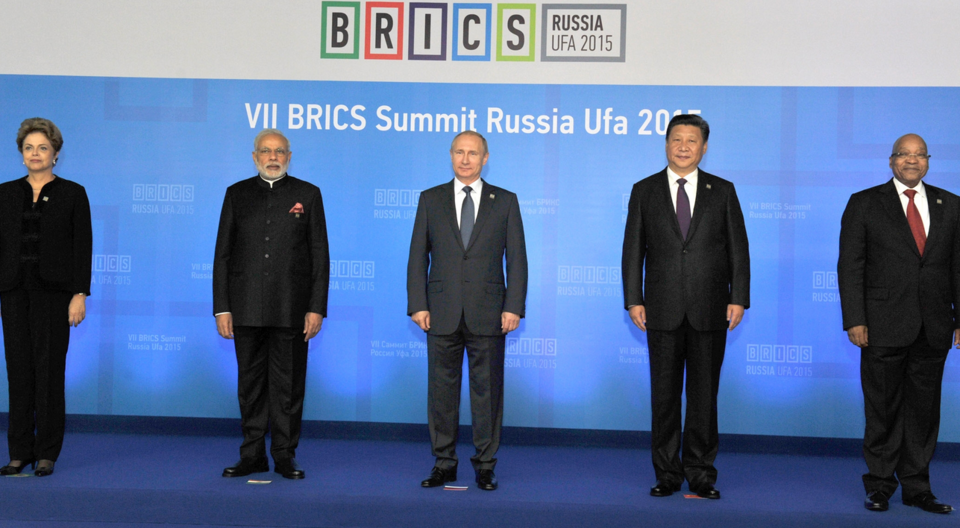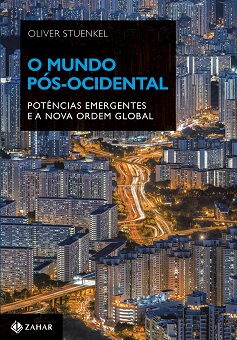
Assessing whether a multilateral summit was a success or not is notoriously difficult. Observers’ expectations and definitions of success can vary greatly, and, more importantly, it may take years to grasp the ramifications of international agreements. As Henry Kissinger writes in World Order (reviewed here), the 24-hour news cycle and social media make traditional diplomacy far more difficult, and policy makers are forced to provide immediate statements after meetings, providing little space for ideas that go beyond soundbites.
It does not help that while government-aligned news agencies such as Russia Today (RT) and Xinhua often provide exaggerated praise when writing about the BRICS, Western newspapers such as the Financial Times or think tanks like Brookings provide remarkably one-sided and excessively critical analyses that regard the grouping as either non-sensical or threatening.
The documents signed at the 7th BRICS Summit in Russia (all available here) provide some important insights about the current dynamics that shape the grouping — and how to think about its potential in the coming years. The vast majority of pundits commenting on the summit will not look at them — they are over one hundred pages long in their entirety — but there are worth looking at: A recent study by the University of Toronto shows that the BRICS achieved 70% compliance with the Fortaleza Summit Commitments made in 2014, continuing its high rate of compliance from previous summits. The authors conclude that “the BRICS countries complied well with the development commitments at the core of their agenda (with an average of +0.60 or 80% over all four summits)”, but also point out that performance on trade issues is uneven, with an overall average of +0.10 (55%). That shows that the final summit declarations are more than just empty statements. What are the key issues to be aware of in the Ufa Declaration?
Multilateral institutions
Similar to all previous declarations, the BRICS’ Ufa Declaration (the main document, available for download here) repeatedly underlines the grouping’s “commitment to the United Nations as a universal multilateral organization entrusted with the mandate of helping the international community maintain international peace and security, advance global development and promote and protect human rights.” Several paragraphs in the declaration are dedicated to specific UN agencies, such as UNCTAD, UNESCO and UNIDO, the UN Global Counter-Terrorism Strategy, the Financial Action Task Force (FATF) and UN Convention against Corruption (UNCAC). In the same way, the BRICS affirm their commitment to the World Trade Organization (WTO). That points to a reality often overlooked by Western analysts: The BRICS do not seek to overthrow global order; rather, they seek to reform some existing structures or create complementary ones. None of the BRICS grouping’s proposals question the basic rules and norms that undergird today’s global order, and the legitimacy of key institutions, such as the UN Security Council, is not questioned.
UN Security Council Reform: No BRICS consensus
Just like in all the previous declarations, China and Russia “reiterate the importance they attach to the status and role of Brazil, India and South Africa in international affairs and support their aspiration to play a greater role in the UN.” In essence, that means that China and Russia do not explicitly support Brazil’s and India’s campaign to gain permanent UNSC membership. Notably, that makes China (and to some degree, Russia) more hostile to Brazil’s and India’s position than the other permanent members. The United States openly support India’s candidacy, while Great Britain and France support both India’s and Brazil’s campaign. Beijing is unlikely to change its stance on this subject anytime soon, and it underlines, to some degree, its role as status quo powers unwilling to push for more fundamental reform of global order.
International Law and the War in Ukraine
In what is possibly the most controversial part of the Ufa Declaration from a Western perspective, the BRICS countries assert that
peaceful coexistence of nations is impossible without universal, scrupulous and consistent application of the generally recognized principles and rules of international law. The violation of its core principles results in creation of situations threatening international peace and security. We insist that international law provides tools for achieving international justice, based on principles of good faith and sovereign equality. We emphasize the need for universal adherence to principles and rules of international law in their interrelation and integrity, discarding the resort to “double standards” and avoiding placing interests of some countries above others.
They also state that
We condemn unilateral military interventions and economic sanctions in violation of international law and universally recognized norms of international relations.
While these affirmations do not include a direct reference to the ongoing conflict in Eastern Europe (Ukraine only appears once at the end of the declaration), some observers are likely to accuse the BRICS of failing to condemn Russia’s annexation of Crimea, arguing that emerging powers seek the privilege to break the rules if necessary or be selective about them — just like the United States has done frequently since the end of World War II, and most egregiously in 2003 when it invaded Iraq without a UN mandate.
Strengthening intra-BRICS ties / The Strategy for the BRICS Economic Partnership
The BRICS leaders say they
strive to facilitate market inter-linkages, robust growth and an inclusive and open world economy characterized by efficient resource distribution, free movement of capital, labour and goods, and fair and efficiently regulated competition.
Reducing obstacles to greater movement of capital, labor and goods between BRICS countries clearly is the grouping’s major challenge. Looking to commitments made at past summits, the only commitment on which BRICS countries failed to make any progress was the one on reforming the Dispute Settlement Understanding (DSU) of the World Trade Organization (WTO). Despite long-standing support of multilateral trade and the WTO’s primacy, BRICS members were unable to advance negotiations on DSU reform during the monitoring period. There has been some progress in the realm of visa rules, but policy makers have not been able to agree on a BRICS-wide visa waiver agreement (Read also: The case for a BRICS visa waiver agreement)
The Strategy for the BRICS Economic Partnership (read full document here) sets out key guidelines for expanding trade and investment, manufacturing and minerals processing, energy, agricultural cooperation, science, technology and innovation, financial cooperation, connectivity and ICT cooperation. While all eyes in the next years will be on the New Development Bank, the ultimate success of the BRICS grouping will, to a great part, be defined by members’ capacity to cooperate economically.
The declaration also mentions strengthening cooperation in the G20, where the BRICS have been able to cooperate on an ad hoc basis on some issues (Read also: Can the BRICS Co-operate in the G-20? A View from Brazil).
The New Development Bank (NDB) and the Contingent Reserve Agreement (CRA)
As expected, the Ufa meeting marks the inauguration of the New Development Bank and the Reserve Agreement, the first tangible institutional manifestations of the BRICS grouping. This is indeed a historic achievement, even though the greatest challenges lie ahead: Many such projects have been announced with much pomp but never took off (Read also: BRICS: Greatest challenges lie ahead).
In the Ufa Declaration, leaders say that
the NDB shall serve as a powerful instrument for financing infrastructure investment and sustainable development projects in the BRICS and other developing countries and emerging market economies and for enhancing economic cooperation between our countries.
While the first loans are likely to be given to projects in BRICS countries, the NDB will seek to support project in other developing countries in the coming years in an effort to show that they are committed to spreading their wealth and assuming international leadership. (Read also: Can the BRICS avoid the “Power South vs. Poor South” Dynamic?)
Expanding the use of national currencies
The BRICS did not make any significant progress as they seek to gradually reduce the dominance of the US-dollar. Since China’s yuan is the only currency with a serious chance to become a global reserve currency, the project largely depends on Beijing’s willingness to move ahead. The statement is thus rather bland:
We acknowledge the potential for expanding the use of our national currencies in transactions between the BRICS countries. We ask the relevant authorities of the BRICS countries to continue discussion on the feasibility of a wider use of national currencies in mutual trade.
Internet governance
As argued before (Read also: Dilma Rousseff’s BRICS challenge), Russia attempted to include a series of ideas ahead of the summit that would have generated strong criticism in the West, such as arguing for the UN’s International Telecommunication Union (ITU) to replace the US government as the ICANN overseer. Many critics of this idea say that it would allow authoritarian regimes to challenge the open Internet. While China was supportive of the idea, Brazil was unsupportive, considering its leadership on the matter at the 2014 NetMundial in São Paulo. In the Ufa Declaration, the topic is approached in a rather uncontroversial way: “It is necessary to ensure that UN plays a facilitating role in setting up international public policies pertaining to the Internet.”
Additional initiatives
The Ufa Declarations includes a long list of new initiatives, ranging from the creation of a platform of joint discussion for trade cooperation amongst BRICS countries through enhanced dialogue between the BRICS Export Credit Agencies, stronger cooperation in the area of e-commerce, as well as a commitment to enhance existing ones, such as tax administration (Read also: Understanding intra-BRICS cooperation: The case of tax administration), energy, agriculture, science, technology and public health — issues that are specified in more detail in the Ufa Action Plan (available for download here) and the other documents. Finally, the BRICS will explore the possibility of developing a BRICS website “as a virtual secretariat — a move that may help observers understand the scope of intra-BRICS cooperation better (Read also: The BRICS’ imperfect communication strategy).
As is the case with most such declarations, the Ufa Summit’s final document — 43 pages long — contains a large number of truisms of little tangible consequence, such as the rather obvious comments on the conflict in Burundi, the Central African Republic or Afghanistan (“We believe that a broad and inclusive national reconciliation in Afghanistan which is Afghan-led and Afghan-owned is the surest path to the lasting peace”).
The history of the BRICS grouping can be divided into three phases. In the first phase (2001-2007), “BRIC” (then still without South Africa) stood for little more than an investment category invented by Goldman Sachs. The second phase (2008-2014) saw the emergence of the BRICS as a political platform, though of largely informal nature. 2015 began the transition to a third phase, marked by a process of institutionalization and the launch of the New Development Bank and the Contingent Reserve Agreement. Institutionalization generates ample opportunities, but also global expectations, making it easier to judge the grouping’s performance and capacity to address global challenges.
Read also:
BRICS and SCO: Russia’s Big Summit
As Brazil’s Senate approves creation of BRICS Bank, grouping enhances parliamentary cooperation
Dilma Rousseff’s BRICS challenge
Connecting the Global South: Why the BRICS Academic Forum matters
Photo credit: BRICS2015 official website








